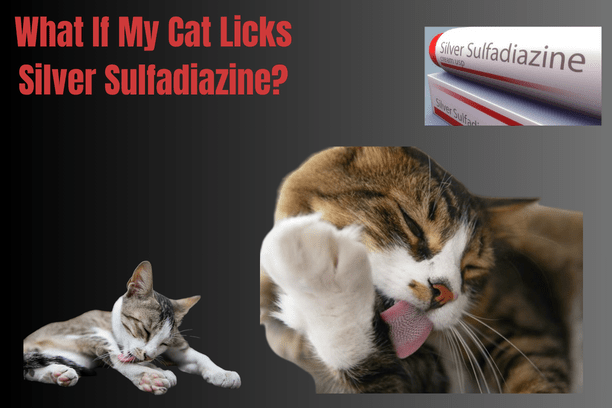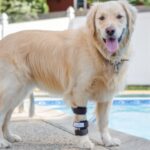If you have a cat, you may be familiar with silver sulfadiazine, a topical cream that is used to treat burns and prevent infections. This cream contains silver, which has antibacterial properties, and sulfadiazine, which is an antibiotic. However, Many pet owners are worried and think, what if my cat licks silver sulfadiazine?
Is it safe or harmful for your feline friend? In this article, we will explore the potential side effects and precautions of using silver sulfadiazine cream for cats. We will also provide some tips on how to apply the cream correctly and safely to your cat. By reading this article, you will learn more about this common but potentially dangerous medication for cats.
Contents
Potential Side Effects what if my cat licks silver sulfadiazine?
While silver sulfadiazine cream can be beneficial for healing wounds and skin conditions in cats, it can also cause some side effects if ingested. Some of the possible side effects are
Allergic reactions
Some cats may be allergic to silver sulfadiazine or its components. This can cause symptoms such as itching, swelling, redness, hives, or difficulty breathing. If you notice any signs of an allergic reaction in your cat, stop using the cream and contact your veterinarian immediately.
Staining of the fur
Silver sulfadiazine can stain the fur of your cat a bluish-gray color. This is usually temporary and harmless, but it can affect the appearance of your cat. To prevent this, you can try to cover the treated area with a bandage or a cone collar to prevent your cat from licking it.
Gastrointestinal upset
Ingesting silver sulfadiazine can irritate the stomach and intestines of your cat, leading to symptoms such as vomiting, diarrhea, loss of appetite, or abdominal pain.
These symptoms are usually mild and self-limiting, but they can also cause dehydration or electrolyte imbalance in your cat. To avoid this, you can give your cat plenty of water and monitor their food intake. See your veterinarian if the symptoms worsen or continue.
Hematologic disorders
Silver sulfadiazine can affect the blood cells of your cat, especially if used for a long time or in large amounts. This can cause conditions such as anemia, leukopenia, or thrombocytopenia, which are characterized by low levels of red blood cells, white blood cells, or platelets, respectively.
These conditions can impair the immune system, oxygen delivery, or blood clotting of your cat, leading to serious complications. To prevent this, you should follow the dosage and duration of treatment prescribed by your veterinarian and have your cat’s blood tested regularly.
Neurologic disorders
Silver sulfadiazine can also affect the nervous system of your cat, especially in young or pregnant cats. This can cause symptoms such as seizures, tremors, ataxia, or depression.
These symptoms are rare and usually reversible, but they can also be life-threatening. To prevent this, you should avoid using silver sulfadiazine in cats that are less than four weeks old, pregnant, or have a history of seizures or other neurological problems.
How to Apply Silver Sulfadiazine Cream to Your Cat
If your veterinarian has prescribed silver sulfadiazine cream for your cat, you should follow these steps to apply it correctly and safely:
- Clean the affected area with a mild antiseptic solution and dry it gently with a clean towel.
- Apply a thin layer of silver sulfadiazine cream to the wound or lesion, covering it completely. Avoid massaging or rubbing the lotion into your skin..
- Cover the treated area with a sterile gauze or a non-stick bandage to protect it from dirt and bacteria. You can also use a cone collar or an Elizabethan collar to prevent your cat from licking or scratching the area.
- Change the dressing and reapply the cream once or twice a day, or as directed by your veterinarian. Discard any leftover cream after each use.
- Wash your hands thoroughly after handling the cream or the wound. Avoid contact with your eyes, nose, or mouth. If you accidentally get some cream in these areas, rinse them with water immediately.
- Store the cream in a cool, dry place, away from sunlight and heat. Keep it out of children’s and other animals’ reach.
Related To Cats Health: Can Cats Eat Butter?
Cat Not Eating After Dental Surgery
Alternatives to Silver Sulfadiazine
Silver sulfadiazine is a topical cream that is widely used to treat burns and prevent infections. It contains silver, which has antibacterial properties, and sulfadiazine, which is an antibiotic.
However, some people may have allergies, side effects, or contraindications to using this cream. In such cases, they may look for some alternatives to silver sulfadiazine. Here are some of the possible alternatives that may be used for burn wound care.
Antimicrobial Agents
Other antimicrobial agents can be applied to the burn wound surface, which can help prevent or treat infection. Some of the commonly used agents are:
- Mafenide acetate: This is a topical solution or cream that has broad-spectrum antibacterial activity. It can penetrate eschar (dead tissue) and reach deep tissues. However, it can also cause pain, burning, or stinging sensation when applied. It can also cause metabolic acidosis, hyperventilation, or skin rash in some patients. It should be used with caution in patients with renal impairment or pulmonary disease.
- Silver nitrate: This is a topical solution that has antiseptic and caustic properties. It can form a protective layer on the wound surface and prevent fluid loss. However, it can also cause staining of the skin, clothes, and equipment. It can also cause electrolyte imbalance, especially hyponatremia or hypochloremia, in patients with large or deep burns.
- Chlorhexidine: This is a topical antiseptic that has bactericidal and fungicidal activity. It can reduce the bacterial load and prevent colonization of the wound. However, it can also cause skin irritation, allergic reactions, or contact dermatitis in some patients. It should be avoided in patients with known hypersensitivity to chlorhexidine or its components.
Biological Dressings
There are also biological dressings that can be used to cover the burn wound and promote healing. Some of the commonly used dressings are:
- Allografts: These are skin grafts obtained from human cadavers or living donors. They can provide temporary coverage and protection of the wound, reduce pain and fluid loss, and stimulate re-epithelialization. However, they can also carry the risk of disease transmission, immune rejection, or infection. They should be screened for pathogens and matched for blood type and tissue antigens before use.
- Xenografts: These are skin grafts obtained from animal sources, such as pigs or cows. They can also provide temporary coverage and protection of the wound, reduce pain and fluid loss, and stimulate re-epithelialization. However, they can also cause immune reactions, inflammation, or infection. They should be treated with chemicals or radiation to reduce their antigenicity and immunogenicity before use.
- Biosynthetic dressings: These are dressings made from synthetic materials, such as polymers or collagen, that are combined with biological components, such as growth factors or cells. They can mimic the structure and function of natural skin and enhance wound healing. However, they can also cause allergic reactions, inflammation, or infection. They should be tested for biocompatibility and sterility before use.
What are the side effects of sulfadiazine?
Sulfadiazine is an antibiotic that is often used to treat or prevent infections caused by bacteria. Like any drug, though, some people may experience negative effects from it. Some of the common side effects of sulfadiazine are:
- Nausea, vomiting, diarrhea, stomach pain, loss of appetite
- Headache, ringing in the ears, dizziness, insomnia, depression
- Numbness, tingling, or burning pain in the hands or feet
- Allergic reactions, such as itching, swelling, rash, or difficulty breathing
Some of the rare but serious side effects of sulfadiazine are:
- Anemia, leukopenia, or thrombocytopenia, are conditions that affect the blood cells and can cause weakness, infections, or bleeding problems
- Liver problems, which can cause jaundice, dark urine, or abdominal pain
- Kidney problems, which can cause decreased urine output, swelling, or blood in the urine
- Neurologic problems, such as seizures, tremors, ataxia, or hallucinations.

Conclusion
Silver sulfadiazine is a useful medication for treating burns and skin infections in cats, what if my cat licks silver sulfadiazine? but it can also cause some side effects if ingested by your cat.
Therefore, you should use it with caution and under the supervision of your veterinarian. You should also monitor your cat for any signs of adverse reactions and seek veterinary attention if needed. By following these tips, you can help your cat heal faster and safer.
FAQs: what if my cat licks silver sulfadiazine?
Q: Is it safe for cats to lick silver sulfadiazine cream?
A: Silver sulfadiazine cream is a topical medication that is used to treat burns and prevent infections in cats. However, if your cat licks the cream of their skin, it can cause some side effects, such as allergic reactions, staining of the fur, gastrointestinal upset, hematologic disorders, or neurologic disorders. Therefore, you should use the cream with caution and under the supervision of your veterinarian. You should also monitor your cat for any signs of adverse reactions and seek veterinary attention if needed.
Q: Is silver sulfadiazine cream poisonous?
A: Silver sulfadiazine cream is not poisonous in small amounts, but it can cause some side effects if ingested or applied to the wrong area. Some of the possible side effects are allergic reactions, staining of the skin, gastrointestinal upset, hematologic disorders, or neurologic disorders. Therefore, you should use the cream with caution and under the direction of your doctor. You should also monitor yourself for any signs of adverse reactions and seek medical attention if needed.
Q: Is sulfadiazine safe for cats?
A: Sulfadiazine is an antibiotic that is often combined with silver to form silver sulfadiazine cream. Sulfadiazine is generally safe for cats when used as prescribed, but it can also cause some side effects, such as allergic reactions, hematologic disorders, or liver problems. Therefore, you should use sulfadiazine with caution and under the supervision of your veterinarian. You should also monitor your cat for any signs of adverse reactions and seek veterinary attention if needed.
Q: Can silver sulfadiazine cream be used for rash?
A: Silver sulfadiazine cream is mainly used for treating burns and preventing infections, but it can also be used for other skin conditions where there is a risk of bacterial infection, such as ulcers, cuts, abrasions, or rashes. However, you should consult your doctor before using silver sulfadiazine cream for rash, as it may not be suitable for your condition. You should also follow the instructions on how to apply the cream and watch out for any side effects.




